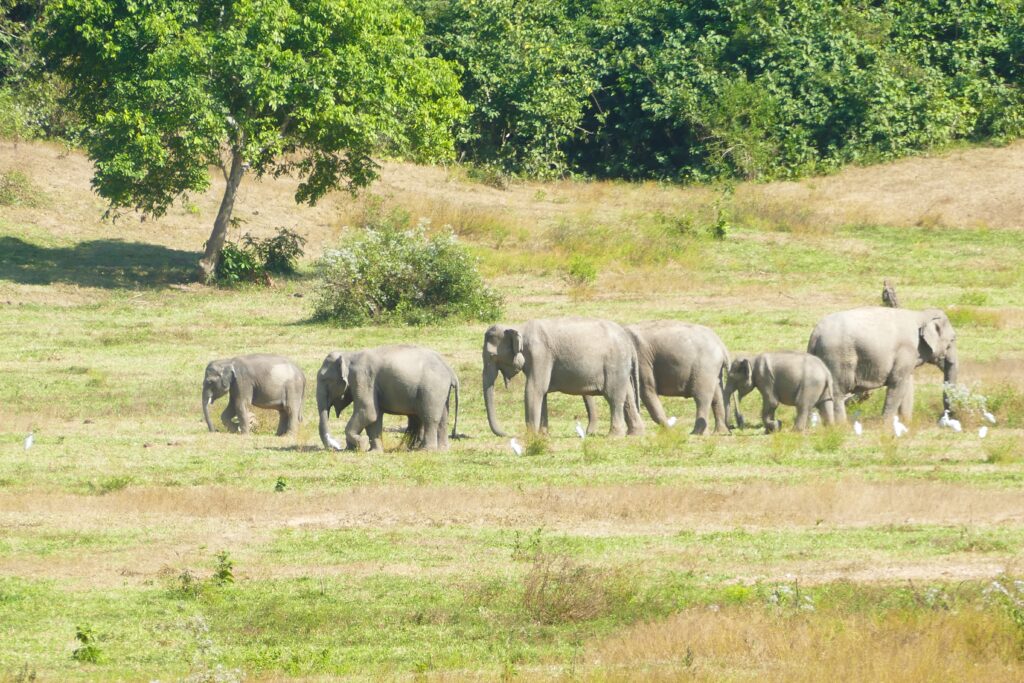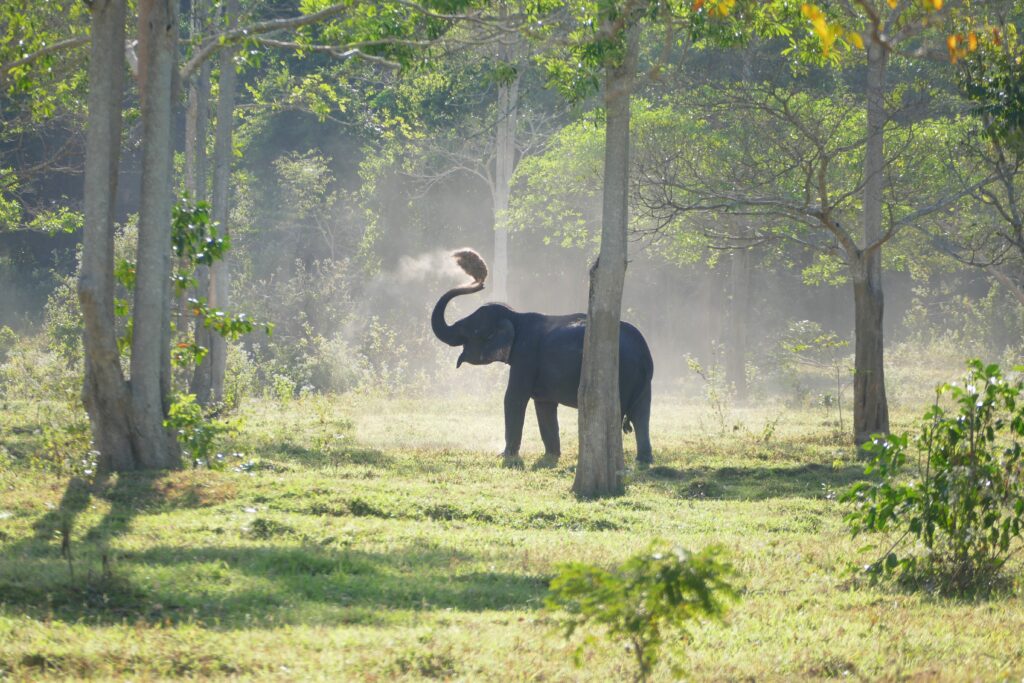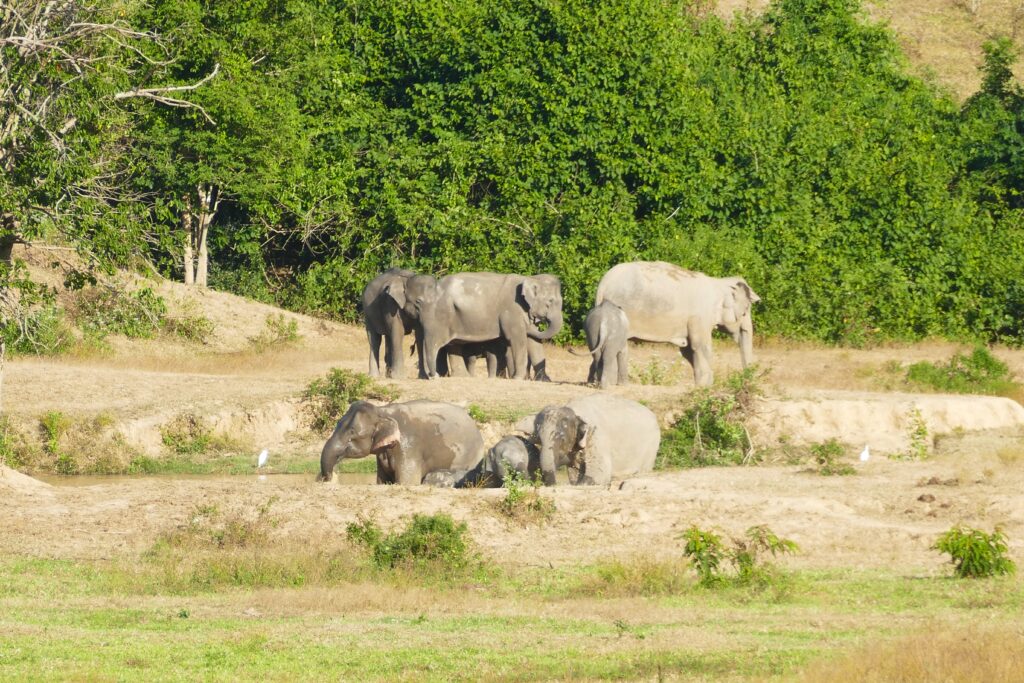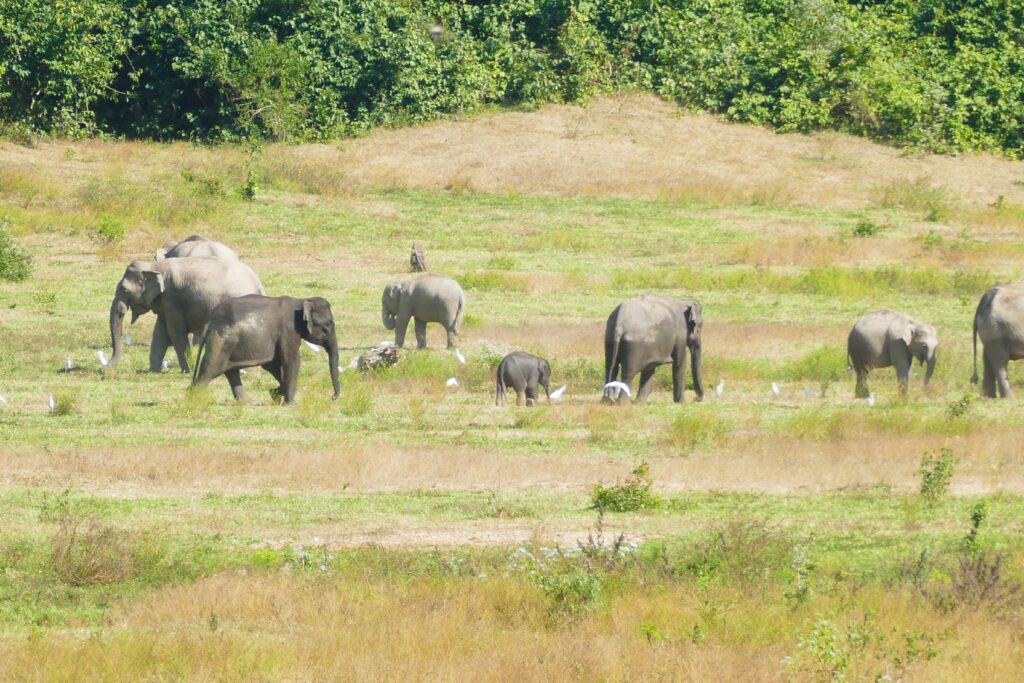“Having elephants has accompanied my family for the last six generations. I have been riding elephants throughout my whole childhood, since I was six years old,” remembers Ray, while he shows us around his premises. He is one of the thousands of Thais who make their living working in the elephant tourism industry. But compared to the majority of the other elephant camps in the country, Ray’s elephants can exercise their freedom of choice.
Elephants have been a staple in the tourism industry in Thailand since the 1970s, and are considered a major attraction for tourists seeking unique and cultural experiences. However, the use of elephants in tourism has been a subject of controversy and ethical concerns, prompting a shift towards more responsible and sustainable practices. At the same time, the country’s wild elephant population is facing a decline due to habitat loss, human-elephant conflict and poaching. With almost 4000 elephants living in various conditions in captivity, compared to an estimated 3500 elephants in the wild – a number that is showing a decreasing trend – the state of Asian elephants in Thailand is at a critical juncture.
Recognizing the need for the conservation of the wild population and ethical treatment of elephants in captivity, organisations and sanctuaries in Thailand have emerged to rescue elephants from exploitative situations, while working on innovative solutions to mitigate human-wildlife conflict.
The cruel reality of Thailand’s elephant tourism
Captive elephants in Thailand have faced a myriad of challenges, ranging from harsh working conditions to inadequate living environments. Traditionally, elephants have been used for labour, transportation, and even in cultural festivals. Although there have been efforts to regulate and improve the welfare of captive elephants, many still endure hardships. Wildlife attractions, particularly concerning elephants used for entertainment, are among the most popular activities with tourists that travel to Thailand. These attractions have been increasingly profitable and the elephant tourism market has significantly expanded. According to the international NGO World Animal Protection, nearly three quarters of captive elephants in Asia are used in Thailand, and its 2019–2020 research identifies Thailand “as a continuing hotspot for elephant suffering” due to the number of elephants involved and the high level of cruelty applied in their handling.
Numbers clearly show how the expanding tourism industry fuels cruel practices towards wildlife, as the overall number of captive elephants used for tourism has increased by 70% in just 10 years in Thailand, accompanied by a 135% increase in the number of elephants living in very bad, low welfare conditions. Of course tourists don’t intend to support any business that causes harm to animals, but many attractions are cleverly rebranded as “sanctuary”, “refuge”, “retirement home”, “haven” or “rescue centre” simply for marketing purposes, fooling the common visitor. When one sees elephants in such camps, they seem to be gentle giants. However, most of them suffered to get there.
Most captive baby elephants across Asia are subjected to ‘The crush’. Separated from their mothers, they enter a process designed to establish human dominance. Baby elephants are forced into small cages where they are unable to move, they are systematically tortured until they stop resisting, and stop showing any kind of defensive behaviour. The process lasts until their wild spirits are broken, after which they’re released, ready to be taught to carry humans on their backs, pull heavy objects, dance, paint, ride the bicycle, play football or bow.
Towards ethical practices
But there is a noticeable shift in demand, and a few elephant camps started changing direction. “I see that my elephants are happier and less tired since they are able to do what they want. I see it from their eyes, facial expressions and behaviour,” tells us Ray as he takes us around the ‘Following Giants’ ethical elephant sanctuary on the island of Koh Lanta. Following Giants is one of only ten elephant camps in Thailand that are certified by the World Animal Organisation, and follow its guidelines.





Following Giants was founded by Ray, and it aims to be one of the pioneers of responsible elephant tourism in Thailand. Here, the emphasis is on observing elephants in their natural behaviour, while riding, bathing with the visitors or unnatural performances are not allowed.
Ray began working in the elephant tourism industry 18 years ago. “Back then I started with one elephant, I took him to the sea for swimming. Elephants actually like drinking salt water in small quantities, it keeps the skin clean,” recalls Ray, as we follow one of the sanctuary’s elephants on her daily foraging walk. In 2017, Ray met the World Animal Protection for the first time, he took a chance, and began the transition towards an elephant-friendly business model. Shortly after reopening, the Covid pandemic hit, and the World Animal Protection financially supported him in these first, unexpectedly challenging years.
At Following Giants, there is no riding, bathing, feeding or touching. Visitors can instead follow the elephants from a safe distance, observe them and learn about their behaviour from an experienced guide. The six elephants of the sanctuary spend their day foraging and visiting the feeding locations in the property, as they need to consume 10% of their body weight every day. “It is better this way. I see the difference in the behaviour of my elephants, and this change is invaluable for me,” Ray explains. “I grew up with elephants, but it took me decades to realise that bathing and feeding is still forcing elephants, and it is much better to let them decide for themselves.” Following Giants, limits its group sizes and visitor numbers each day, while most other camps don’t take this approach. “I want more camp owners to follow our criteria. However, only on Koh Lanta, in the high season, 500 people daily want to visit elephants. Therefore, most of them will still go to camps that offer direct touch, bathing, and other activities.”
As we walk past a pile of pineapple scraps, Ray tells us that it needs a shocking 3000 kg of food every day to feed six elephants. He speaks with passion when he tells us about his aim to raise the salary of mahouts (the keepers assigned to each elephant). But while inspiring a shift in the tourism industry towards responsible and compassionate practices, he also faces much criticism. “Many families cancel their booking after finding out that there is no touch allowed here. Sometimes we receive criticism about this from tourists, but all we can do is explain that Following Giants is different, that our elephants have the freedom of choice.”
World Animal Protection’s guidelines for ethical elephant camps help to identify which camps follow ethical practices:
- Allow elephants to socialise with one another
- Don’t offer riding, shows, or washing
- Instruct visitors to keep a safe distance from the elephants
- Elephant mahouts (trainers) should be trained to guide their elephants humanely when necessary, but mostly let them roam freely, allowing for natural behaviours
- Mahouts should be treated respectfully and paid a living wage
- Elephants should not be restrained by chains during the day, and ideally kept in enclosures or large pens at night
- Elephants should be given a varied diet, consisting of fresh, natural food, and be able to forage for food themselves
- Elephants shouldn’t be bred in captivity — camps should focus on providing care for existing elephants
While running an ethical sanctuary, Ray’s perspective on elephant tourism highlights a crucial tension in the industry. Many sanctuaries prioritise profit over elephant welfare. They exploit breeding and activities like riding and bathing to generate income, despite keeping the elephants in poor conditions. Meanwhile, Ray believes elephant welfare should be paramount. He aims to rescue elephants by buying them, to remove them from exploitative situations. He also aims to create new sanctuaries, to provide large, elephant-friendly spaces for rescued animals to roam freely. And last but not least, he hopes to expand his ethical sanctuary model alongside a shift in tourist awareness.



Being the sixth generation of elephant owners in his family, Ray is glad to share his own journey and shift to ethical elephant tourism with visitors.
However, there are various challenges in his way. His approach needs income from tourism to fund the sanctuaries, but ethical tourism experiences are less lucrative. Shifting tourist demand is also not an easy task. Ray’s approach requires a decrease in demand for traditional, exploitative elephant activities.
Overall, Ray’s approach has merit. It directly helps elephants, raises awareness, and offers an alternative to exploitative tourism. However, its success hinges on a larger shift in tourist preferences towards ethical experiences. If this was achieved, Thailand would be on the forefront of creating an alternative model of interacting with elephants.
What’s happening in the wild?
Meanwhile, the population of wild elephants in Thailand is facing various challenges, primarily connected to habitat loss, human-elephant conflict and poaching. As urbanisation continues to encroach upon natural habitats, the once-expansive territories of wild elephants have been fragmented, leading to increased conflicts with local communities.
We are eager to visit one of these communities ourselves, which is why it’s exciting to roll into Kui Buri National Park, which nurtures one of Thailand’s largest populations of wild elephants.
Impressions from Kui Buri National Park and its elephants.
This is the place where Bring the Elephant Home (BTEH), a conservation organisation dedicated to protecting wild elephants, is located. Ave, country director of Thailand, welcomes us with a big smile. A journalist by first education who fell in love with Thailand and elephants, Ave has a deep understanding of elephants in captivity in the country, and at BTEH, they mostly work with the community to implement sustainable and innovative solutions to human-elephant conflict.
Here in Kui Buri, which provides home to over 300 elephants. Wild elephants often leave the forest at night to raid crops from nearby farms, and even one individual can cause significant damage to the year’s harvest in one night. Therefore, farmers do their best to protect their livelihood and even sleep at their fields every night to guard their crops from elephants, while having a tight communication network for elephant sightings.


The landscape outside and inside Kui Buri National Park. The park forest consists of dry and moist evergreen forests, and is considered the best wild elephant watching spot in Thailand. Meanwhile, in the region, mostly pineapple (a favourite snack of elephants) covers the farmlands as far as the eye can see.
Unattractive for elephants? Let’s farm it!
One of BTEH’s projects, a community-based conservation initiative, is called the ‘Tom Yum Project’, named after the famous Thai soup. By supporting farmers to grow natural elephant deterrent crops – also found in the spicy Tom Yum soup – the project aims to promote coexistence while also protecting local livelihoods. “Almost 50% of farmers in Thailand plant pineapple at a loss, while there are many crops that elephants don’t like that are not yet cultivated on a large scale, although being economically viable,” Ave tells us. “Together with the local community, we identified which crops suffer from elephant damage, and for 22 months, we experimented with alternative crops.” According to the collected data, lemongrass and citronella came out as winners due to their drought resistance, but lime, ginger, chili, mulberry and turmeric also proved to be unpalatable to elephants, while also creating new economic opportunities for the community.


Crops planted within the Tom Yum project also make a great ingredient in teas as well as scented candles and soaps that are sold by Bring the elephant home, and the profits further support the project.
Bees to the rescue
Similarly creative is their project on beehive fences. As it turns out, despite their thick skin and imposing size, elephants are terrified of bees, and for good reasons. When elephants disturb a beehive, they trigger its defensive swarming response, which leads to bees stinging the sensitive tissue on the inside of their trunks.
This is why elephants have a specific bee alarm, a vocalisation they use to warn others when they get close to a beehive. As scientists have shown in recent years, a fence made of beehives can be an effective deterrent. Its brilliance comes from its simplicity, and as BTEH has proven in its ‘Bee the change’ project, hanging beehives from wooden posts with a long metal wire linking them together works like a charm. When an elephant hits the wire, it shakes the hives and sends honeybees out, swarming in defense. According to BTEH’s study, over 60% of the elephant groups and over 85% of the individual elephants were deterred by the beehive fence. Therefore, for maximum impact, beehive fences should be combined with other methods, such as planting alternative crops. On top of that, BTEH buys the raw honey, ensuring farmers have an additional income source. The honey is processed, labelled as ‘Elephant-friendly Beeyond Honey’ and sold.
Time for a different take on conservation
This is what differentiates BTEH from other conservation organisations who want to impose their practices on local communities without consultation. Instead, the team of BTEH directly works within the community and looks for possibilities to create benefits for them. Each researcher who comes to study elephants with BTEH must also hire a Thai researcher and a local coordinator, which is creating possibilities for locals to participate in research. Equally, decisions and events happen with the involvement of the community, as is field work, and BTEH encourages ecotourism and businesses based on selling local handicraft in the village. “Everything we do is community-centric. Our main mission is to help locals, not completely extinguish conflict,” emphasises Ave. By helping farmers profit from elephant-friendly practices, the work of BTEH give locals a clearer financial stake in these wild animals’ continued existence.










